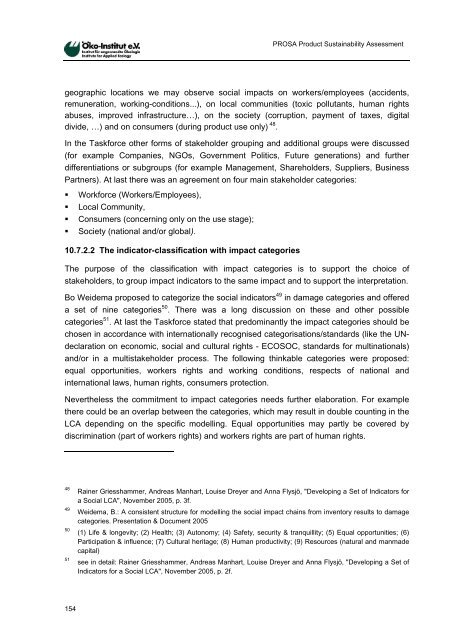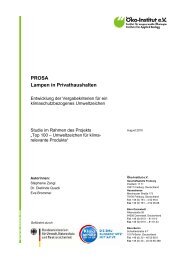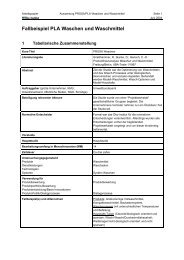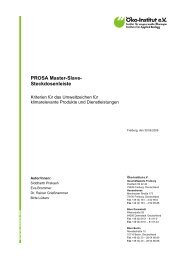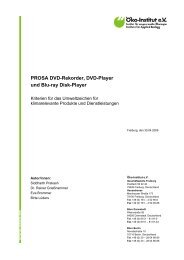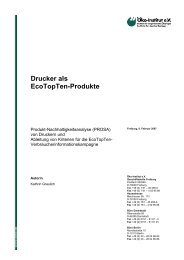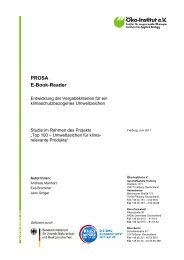PROSA – Product Sustainability Assessment - PROSA - Produkt ...
PROSA – Product Sustainability Assessment - PROSA - Produkt ...
PROSA – Product Sustainability Assessment - PROSA - Produkt ...
Erfolgreiche ePaper selbst erstellen
Machen Sie aus Ihren PDF Publikationen ein blätterbares Flipbook mit unserer einzigartigen Google optimierten e-Paper Software.
<strong>PROSA</strong> <strong>Product</strong> <strong>Sustainability</strong> <strong>Assessment</strong><br />
geographic locations we may observe social impacts on workers/employees (accidents,<br />
remuneration, working-conditions...), on local communities (toxic pollutants, human rights<br />
abuses, improved infrastructure…), on the society (corruption, payment of taxes, digital<br />
divide, …) and on consumers (during product use only) 48 .<br />
In the Taskforce other forms of stakeholder grouping and additional groups were discussed<br />
(for example Companies, NGOs, Government Politics, Future generations) and further<br />
differentiations or subgroups (for example Management, Shareholders, Suppliers, Business<br />
Partners). At last there was an agreement on four main stakeholder categories:<br />
• Workforce (Workers/Employees),<br />
• Local Community,<br />
• Consumers (concerning only on the use stage);<br />
• Society (national and/or global).<br />
10.7.2.2 The indicator-classification with impact categories<br />
The purpose of the classification with impact categories is to support the choice of<br />
stakeholders, to group impact indicators to the same impact and to support the interpretation.<br />
Bo Weidema proposed to categorize the social indicators 49 in damage categories and offered<br />
a set of nine categories 50 . There was a long discussion on these and other possible<br />
categories 51 . At last the Taskforce stated that predominantly the impact categories should be<br />
chosen in accordance with internationally recognised categorisations/standards (like the UNdeclaration<br />
on economic, social and cultural rights - ECOSOC, standards for multinationals)<br />
and/or in a multistakeholder process. The following thinkable categories were proposed:<br />
equal opportunities, workers rights and working conditions, respects of national and<br />
international laws, human rights, consumers protection.<br />
Nevertheless the commitment to impact categories needs further elaboration. For example<br />
there could be an overlap between the categories, which may result in double counting in the<br />
LCA depending on the specific modelling. Equal opportunities may partly be covered by<br />
discrimination (part of workers rights) and workers rights are part of human rights.<br />
48<br />
49<br />
50<br />
51<br />
Rainer Griesshammer, Andreas Manhart, Louise Dreyer and Anna Flysjö, "Developing a Set of Indicators for<br />
a Social LCA", November 2005, p. 3f.<br />
Weidema, B.: A consistent structure for modelling the social impact chains from inventory results to damage<br />
categories. Presentation & Document 2005<br />
(1) Life & longevity; (2) Health; (3) Autonomy; (4) Safety, security & tranquillity; (5) Equal opportunities; (6)<br />
Participation & influence; (7) Cultural heritage; (8) Human productivity; (9) Resources (natural and manmade<br />
capital)<br />
see in detail: Rainer Griesshammer, Andreas Manhart, Louise Dreyer and Anna Flysjö, "Developing a Set of<br />
Indicators for a Social LCA", November 2005, p. 2f.<br />
154


